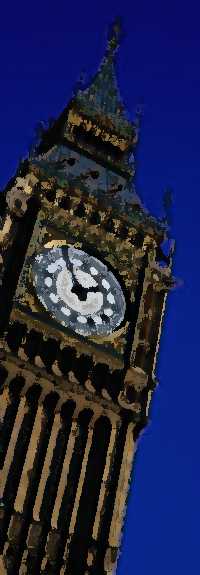Water Clock at Villa
Borghese in Rome
A water
clock or clepsydra is a device for measuring time by letting water regularly flow out of a container usually by a tiny aperture.
Since the rate of flow of water is very difficult to control precisely, water clocks could never achieve high accuracy.
Water clocks
were among the earliest chronometers that did not depend on the observation of celestial bodies. One of the oldest was found
in the tomb of the Egyptian pharaoh Amenhotep I, buried around 1500 BC. Later named clepsydras ("water thieves") by
the Greeks, who began using them about 325 BC, these were stone vessels with sloping sides that allowed water to drip at a
nearly constant rate from a small hole near the bottom. Other clepsydras were cylindrical or bowl-shaped containers designed
to slowly fill with water entering at a constant rate. Markings on the inside surfaces measured the passage of "hours" as
the water level reached them. These clocks were used to determine hours at night, but may have been used in daylight as well.
Another version consisted of a metal bowl with a hole in the bottom; when placed in a container of water the bowl would fill
and sink in a certain time. These were still in use in northern Africa in the 20th century.
More elaborate
and impressive mechanized water clocks were developed between 100 BC and 500 A.D. by Greek and Roman horologists and
astronomers. The added complexity was aimed at making the flow more constant by regulating the pressure and at providing fancier
displays of the passage of time. Some water clocks rang bells and gongs; others opened doors and windows to show little figures
of people, or moved pointers, dials etc. A Macedonian astronomer, Andronikos, supervised
the construction of his Horologion, known today as the Tower of the Winds, in the Athens marketplace in the first half of the 1st century BC. This octagonal
structure showed scholars and shoppers both sundials and mechanical hour indicators. It featured a 24-hour mechanized clepsydra
and indicators for the eight winds from which the tower got its name, and it displayed the seasons of the year and astrological
dates and periods. The Romans also developed mechanized clepsydras, though their complexity accomplished little improvement
over simpler methods for determining the passage of time.
In eastern
Asia, mechanized astronomical and astrological clock making developed from 200 to 1300 CE.
3rd century Chinese clepsydras drove various mechanisms that illustrated astronomical phenomena.
Su
Song's water clock tower
One of the most elaborate clock towers was built by Su Sung (蘇頌) and his associates in 1088. Su Sung's mechanism incorporated
a water-driven escapement invented about 725. The Su Sung clock tower, over 30
feet tall, possessed a bronze power-driven armillary sphere for observations, an automatically rotating
celestial globe, and five front panels with doors that permitted the viewing of changing manikins
which rang bells or gongs, and held tablets indicating the hour or other special times of the day.
Follow the grass on the right of the narrow path, keeping close to the edge: on the opposite
side of the road, the wall soon reaches a height of about 20 metres,
surrounding the northern and It is advisable to walk through Villa Borghese, at a certain distance from the heavy and dangerous
traffic; the wall will remain in sight for most of the way.
eastern side of the steep Pincio Hill; in ancient times, important
families owned houses with gardens in this area: one of them was the Pincii family, whence the name given to the site through
the centuries.
After a rather sharp bend, also the villa's grounds grow steep; here the difference in level with via
del Muro Torto is considerable. We are now climbing towards
the bridge linking Villa Borghese to the Pincio's gardens; as a private property until the early 1900's, Villa Borghese had
no access to the Pincio, which could be reached only from the opposite side of the hill: after becoming a public park (bought
by the king of Italy from the Borghese family), a few years later this bridge was built as a comfortable and charming approach
to the gardens, crossing via del Muro Torto from above.
A quick diversion along these shady avenues, decorated with a large
number of marble busts of outstanding Italian artists and scientists, won't take away much time. Cross the bridge, and follow
the first avenue on the right: you will soon come to a rather unusual water-clock, built in 1807: it is made of wood, and its
mechanism is propelled by water (by a weird coincidence, the name of the author, a priest called Imbriaco, sounds like "drunken"
in roman dialect, a typical pun for local people).
Sources:
http://www.answers.com/topic/villa-borghese
http://mp_pollett.tripod.com/aurel11htm
Group Leader: Luca
P.
Working group: Luca P., Alessio A., GabrieleC.
2nd
form/A
School
year 2004/2005
I.I.S.
Carlo Urbani - Rome/Italy
Coordinator:
Prof. Noemi Lusi
